What is dangerous Goods?
Dangerous goods (also referred to as Hazardous Cargo) means the substances, materials and articles that are covered by the IMDG Code and is cargo that is considered to be hazardous because of its flammable, corrosive, poisonous nature or other properties..
IMDG Code (International Maritime Dangerous Goods) is a code adopted by the Maritime Safety Committee of the International Maritime Organization by resolution MSC.122(75) for the carriage of Dangerous Goods (Hazardous Cargo)..
In this article you will find information pertaining to the various classes of hazardous cargoes, a brief explanation of each and labeling details for the same.. For your convenience you can download the generic Hazardous Cargo Request format & the Hazardous Cargo Packing Declaration format..
In this Hazardous Cargo Packing Declaration form, apart from the correct UN No. and IMCO Class, special attention must be provided to the EmS (Emergency Schedules) and MFAG (Medical & First Aid Guide)..
In the event of an emergency on board, these are the details that the ships personnel look for as guidance to provide medical assistance to anyone injured on board..
Hazardous Substance Class Definitions & Labels
In the IMDG Code, substances are divided into 9 classes. A substance with multiple hazards has one ‘Primary Class’ and one or more ‘Subsidiary Risks’. Some substances in the various classes have also been identified as substances harmful to the marine environment (MARINE POLLUTANTS).
Class 1 – Explosives
Class 2 – Gases; compressed, liquefied or dissolved under pressure
Class 3 – Flammable liquids
Class 4 – Flammable solids; Substances liable to spontaneous combustion; Substances which, in contact with water, emit flammable gases
Class 5 – Oxidizing substances (agents) and organic peroxides
Class 6 – Toxic and infectious substances
Class 7 – Radioactive materials
Class 8 – Corrosives
Class 9 – Miscellaneous dangerous substances and articles Non-classified materials
For the purposes of the IMDG Code, dangerous goods with a melting point or initial melting point of 20 deg C or lower at a pressure of 101.3 kPa should be considered to be liquid, unless there is an explicit or implicit indication to the contrary. A viscous substance for which a specific melting point cannot be determined should be subjected to the ASTM D 4359-90 test. Goods of all classes other than 1, 2, 6.2 and 7 have also been assigned packaging groups according to the degree of danger they present; I – great danger, II – medium danger, or III – minor danger.
Class 1: Explosives
Class 1 comprises:
explosive substances, except those which are too dangerous to transport or those where the predominant hazard is one appropriate to another class; [A substance which is not itself an explosive but which can form an explosive atmosphere of gas, vapour or dust is not included in class 1.]
explosive articles, except devices containing explosive substances in such quantity or of such a character that their inadvertent or accidental ignition or initiation during transport shall not cause any effect external to the device either by projection, fire, smoke, heat or loud noise; and
substances and articles not mentioned above which are manufactured with a view to producing a practical, explosive or pyrotechnic effect.
Transport of explosive substances which are unduly sensitive, or so reactive as to be subject to spontaneous reaction, is prohibited. For the purposes of the IMDG Code the following definitions apply:
An explosive substance is a solid or liquid substance (or a mixture of substances) which is in itself capable by chemical reaction of producing gas at such a temperature and pressure and at such a speed as to cause damage to the surroundings. Pyrotechnic substances are included even when they do not evolve gases.
A pyrotechnic substance is a substance or a mixture of substances designed to produce an effect by heat, light, sound, gas or smoke or a combination of these as the result of non-detonative self-sustaining exothermic chemical reactions.
An explosive article is an article containing one or more explosive substances.
A mass explosion is one which affects almost the entire load virtually instantaneously.
Class 1 is unique in that the type of packaging frequently has a decisive effect on the hazard and therefore on the assignment to a particular division. Where multiple hazard classifications have been assigned, they are listed in the individual schedule. The correct hazard division is determined in accordance with the latest version of the United Nations Recommendations on the Transport of Dangerous Goods, Tests and Criteria (Test Manual).
The six hazard divisions of class 1 are:
Division 1.1 – Substances and articles which have a mass explosion hazard
Division 1.2 –Substances and articles which have a projection hazard but not a mass explosion hazard
Division 1.3 – Substances and articles which have a fire hazard and either a minor blast hazard or a minor projection hazard or both, but not a mass explosion hazard
This division comprises substances and articles:
which give rise to considerable radiant heat; or
which burn one after another, producing minor blast or projection effects or both.
Division 1.4 –Substances and articles which present no significant hazard
This division comprises substances and articles which present only a small hazard in the event of ignition or initiation during transport. The effects are largely confined to the package and no projection of fragments of appreciable size or range is to be expected. An external fire must not cause virtually instantaneous explosion of almost the entire contents of the package.
NOTE: Substances and articles in this division so packaged or designed that any hazardous effects arising from accidental functioning are confined within the package unless the package has been degraded by fire, in which case all blast or projection effects are limited to the extent that they do not significantly hinder fire-fighting or other emergency response efforts in the immediate vicinity of the package, are in compatibility group S.
Division 1.5 – Very insensitive substances which have a mass explosion hazard
This division comprises substances which have a mass explosion hazard but are so insensitive that there is very little probability of initiation or of transition from burning to detonation under normal conditions of transport. NOTE: The probability of transition from burning to detonation is greater when large quantities are carried in a ship. As a consequence, the stowage requirements for explosive substances in division 1.1 and for those in division 1.5 are identical.
Division 1.6 – Extremely insensitive articles which do not have a mass explosion hazard
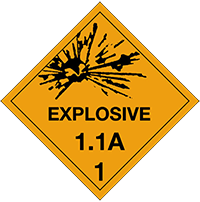
This division comprises articles which contain only extremely insensitive detonating substances and which demonstrate a negligible probability of accidental initiation or propagation. NOTE: The risk from articles of division 1.6 is limited to the explosion of a single article.
Class 2.1 – Gases, 2.2 – Flammable Gases, 2.3 – Non-Toxic/Flammable Toxic Gases
A gas is a substance which:
at 50 deg C has a vapour pressure greater than 300 kPa; or
is completely gaseous at 20 deg C at a standard pressure of 101.3 kPa.
The transport condition of a gas is described according to its physical state as:
Compressed gas, A gas (other than in solution) which when packaged under pressure for transport is entirely gaseous at 20 deg C;
Liquefied gas, A gas which when packaged for transport is partially liquid at 20 deg C;
Refrigerated liquefied gas, A gas which when packaged for transport is partially liquid because of its low temperature;
Gas in solution, Compressed gas which when packaged for transport is dissolved in a solvent.
This class comprises compressed gases; liquefied gases; gases in solution; refrigerated liquefied gases; mixtures of gases; mixtures of one or more gases with one or more vapours of substances of other classes; articles charged with a gas; tellurium hexafluoride; aerosols. Class 2 is subdivided further according to the primary hazard of the gas during transport, into:
Class 2.1 – Flammable gases
Class 2.2 – Non-flammable, non-toxic gasesClass 2.3 – Toxic gases
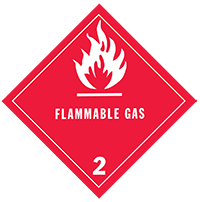
Class 3: Flammable & Combustible Liquids
These are liquids, or mixtures of liquids, or liquids containing solids in solution or suspension (e.g. paints, varnishes, lacquers, etc., but not including substances which, on account of their other dangerous characteristics, have been included in other classes) which give off a flammable vapour at or below 61 deg C (141 deg F) closed cup test (corresponding to 65.6 deg C (150 deg F) open cup test), normally referred to as the flashpoint.
Class 3 also includes:
Liquids offered for transport at temperatures at or above their flashpoint; and
substances transported or offered for transport at elevated temperatures in a liquid state which give off a flammable vapour at temperatures equal to or below the maximum transport temperature.
However, the provisions of the IMDG Code need not apply to such liquids with a flashpoint of more than 35 deg C (95 deg F) which do not sustain combustion. Liquids are considered to be unable to sustain combustion for the purposes of the Code if:
they have passed the suitable combustibility test (see the Sustained Combustibility Test prescribed in Part III, chapter 32.5.2 of the United Nations Manual of Test and Criteria); or
their fire point according to ISO 2592:1973 is greater than 100 deg C; or
they are water-miscible solutions with a water content of more than 90%, by mass
“Inflammable” has the same meaning as “flammable”, Poisonous” has the same meaning as “toxic”. Where the flashpoint is indicated for a volatile liquid it may be followed by the symbol “c.c.”, representing determination by a closed cup test, or by the symbol “o.c.”, representing an open cup test. Liquid desensitized explosives are explosive substances which are dissolved or suspended in water or other liquid substances, to form a homogeneous liquid mixture to suppress their explosives properties. Entries in the Dangerous Goods List for liquid desensitized explosives are: UN 1204, UN 2059, UN 3064 and UN 3343.
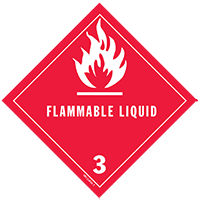
Class 4.1, 4.2, 4.3 : Flammable Solids
Class 4 deals with substances, other than those classed as explosives, which, under conditions of transport, are readily combustible or may contribute to a fire or cause one.
Class 4 is subdivided further, into:
Class 4.1 – Readily combustible solids and solids which may cause fire through friction; Self-reactive (solids and liquids) and related substances; Desensitized explosives. The substances in this class are solids possessing the properties of being easily ignited by external sources, such as sparks and flames, and of being readily combustible, or of being liable to cause fire through friction. This class also covers substances which are self-reactive and related substances (i.e. liable to undergo, at normal or elevated temperatures, a strong exothermic decomposition caused by excessively high transport temperatures or by contamination); and desensitized explosives which may explode if not diluted sufficiently.
Class 4.2 – Substances liable to spontaneous combustion. The substances in this class are either liquids or solids which are liable to spontaneous heating under normal conditions encountered in transport, or to heating up in contact with air, and being then liable to catch fire.
Class 4.3 – Substances which, in contact with water, emit flammable gases. The substances in this class are either liquids or solids which, by interaction with water, are liable to become spontaneously flammable or to give off flammable gases in dangerous quantities. NOTE: Where the term “water-reactive” is used in this context, it refers to a substance which, in contact with water, emits flammable gas.

Class 5.1 – Oxidizing Substances, 5.2 – Organic Peroxides
Class 5 is subdivided further, into:
Class 5.1 – Oxidizing substances (agents). These are substances which, although in themselves not necessarily combustible, may, either by yielding oxygen or by similar processes, increase the risk and intensity of fire in other materials with which they come into contact.
Class 5.2 – Organic peroxides. Organic substances which contain the bivalent -O-O- structure and may be considered derivatives of hydrogen peroxide, where one or both of the hydrogen atoms have been replaced by organic radicals. Organic peroxides are thermally unstable substances, which may undergo exothermic self-accelerating decomposition. In addition, they may have one or more of the following properties:
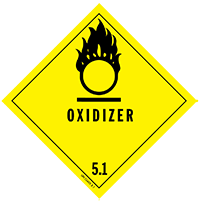
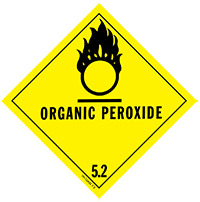
Class 6.1 – Toxic, 6.2 – Infectious Substances
Substance that can poison and cause damage to a any living body, tissue, and nervous system. “Poisonous” has the same meaning as “toxic”.
Class 6 is subdivided further, into:
Class 6.1 – Toxic substances. These are substances liable either to cause death or serious injury or to harm human health if swallowed or inhaled, or by skin contact.
Class 6.2 – Infectious substances. These are substances containing viable micro-organisms, including a bacterium, virus, rickettsia, parasite, fungus or a recombinant, hybrid or mutant, that are known or reasonably believed to cause disease in animals or humans.
Note 1: Genetically modified micro-organisms and organisms which do not meet the definition of an infectious substance of class 6.2 (UN Nos. 2814 and 2900) should be considered for classification in class 9 and assigned to UN No. 3245 – GENETICALLY MODIFIED MICRO-ORGANISMS.
Note 2: Toxins from plant, animal or bacterial sources which do not contain any infectious substance or toxins that are contained in substances which are not infectious substances should be considered for classification in class 6.1 and assigned to UN No. 3172 – TOXINS EXTRACTED FROM LIVING SOURCES, N.O.S.
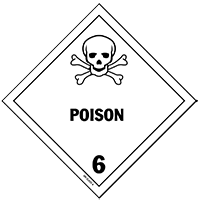
Class 7: Radioactive Materials
Radioactive material means any material containing radionuclides where both the activity concentration and the total activity in the consignment exceed the values specified in IMDG code.
The following radioactive materials are not included in class 7 for the purposes of this Code:
(a) radioactive material that is an integral part of the means of transport;
(b) radioactive material moved within an establishment which is subject to appropriate safety regulations in force in the establishment and where the movement does not involve public roads or railways;
(c) radioactive material implanted or incorporated into a person or live animal for diagnosis or treatment;
(d) radioactive material in consumer products which have received regulatory approval, following their sale to the end user;
(e) natural material and ores containing naturally occurring radionuclides which are not intended to be processed for use of these radionuclides provided the activity concentration of the material does not exceed 10 times the values specified.
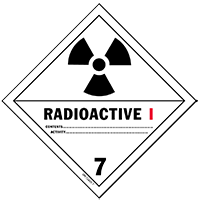
Class 8: Corrosives
Class 8 substances (corrosive substances) means substances which, by chemical action, will cause severe damage when in contact with living tissue or, in the case of leakage, will materially damage, or even destroy, other goods or the means of transport.
A substance which is designated as “stabilized” should not be transported in the unstabilized state
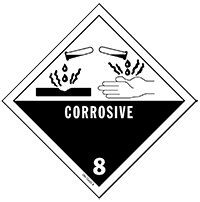
Class 9: Miscellaneous
Class 9 substances and articles (miscellaneous dangerous substances and articles) comprise:
Substances and articles not covered by other classes which experience has shown, or may show, to be of such a dangerous character that the provisions of part A of chapter VII of SOLAS, 1974, as amended, should apply; these include substances that are transported or offered for transport at temperatures equal to. or exceeding 100 deg C, in a liquid state, and solids that are transported or offered for transport at temperatures equal to or exceeding 240 deg C; and
Substances not subject to the provisions of part A in chapter VII of the aforementioned Convention, but to which the provisions of Annex III of MARPOL 73/78, as amended, apply.
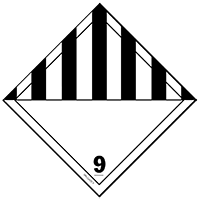
Non-Classified Materials : A “GENERIC” or “NOT OTHERWISE SPECIFIED (N.O.S)” entry may be used to offer for transport by sea a substance, material or article which is not listed by its name in the Dangerous Goods List. Such a substance, material or article may be transported only after:
its dangerous, hazardous and/or harmful properties have been determined;
it has been classified in accordance with the class definitions and criteria; and
the entry that most accurately describes the nature of the goods has been selected.
Once the class of the goods has been established, all applicable requirements for transport laid down in the IMDG Code should be complied with. Any substance, material or article having, or suspected of having, explosive properties or characteristics should first be considered for classification in class 1.
